French-born André Habay or Andrea Habay was a popular actor in Italian silent cinema. He was the leading man in modern dramas and Diva films such as Sangue blu (1914) and Rapsodia Satanica (1917), but he also starred in such historical epics as Quo Vadis? (1925).
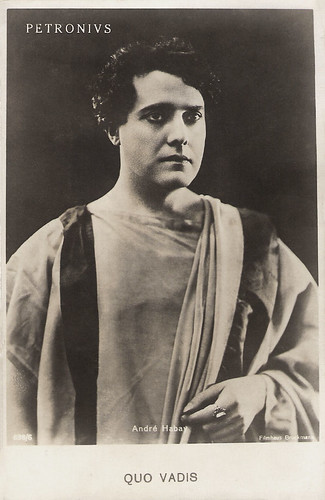
German postcard, no. 698/6. Photo: Filmhaus Bruckmann. André Habay as Petronius in Quo Vadis? (1924-1925).

Probably a British postcard. Photo: K-Ltd.
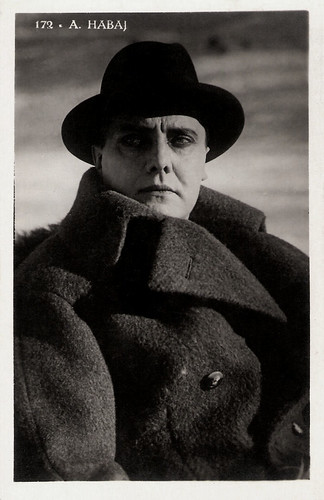
Italian postcard, no. 172.
André Habay (aka Andrea Habay, A. Habaj or A. Kabaj) was born in Paris, France in 1883. Nothing more is known about his French whereabouts.
What we do know is that he had a rich career in Italian silent cinema, which started just before the First World War and continued until the mid-1920s. His first part was probably in the Spanish-Italian film Carmen, directed by Giovanni Doria and Augusto Turqui, and released in Spain in 1914, according to IMDb. Strangely enough, the film lacks in the otherwise excellent reference books of 'Il cinema muto italiano' by Bernardini & Martinelli. French actress Suzy Prim played Carmen, while Habay was Don José. For both, it meant the start of a career in Italian silent film, though Habay's Italian career was more intense and longer-lasting than Prim's.
From 1914 on, Habay worked regularly for Cines or rather its affiliated company Celio. He began as the leading man of diva Francesca Bertini. Their first film together was the tragic melodrama Onestà che uccide/Honesty That Kills (Maurizio Rava, 1914). It was well-received.
Their next film, the spy story La principessa misteriosa/The Mysterious Princess (Maurizio Rava, 1914), repeated the plot of Bertini’s previous L'amazzone mascherata/The Masked Rider (Baldassarre Negroni, 1913) and did not stir much.
Their subsequent film, Sangue blu/Sangue bleu (Nino Oxilia, 1914) was explicitly built up to lift Bertini to the status of a diva, and it succeeded. In all these films Angelo Gallina acted as the older man, as opposed to the younger one, played by Habay. In Sangue Blu Bertini is a countess who divorces her unfaithful husband (Gallina). Acting in a philanthropist stage play, she meets actor Jack Wilson (Habay). A compromising picture of the two makes the countess lose her child. Wilson proves to be a ruthless exploiter who robs her and forces her to act on stage. During a tango of death, she desperately stabs herself but doesn’t die. Her husband repents and the family is reunited. The film was an international success and paved the way for Habay as well.

Italian postcard by Ed. A. Traldi, Milano, no. 6?. Photo: Pinto, Rome. Habay's first name is misspelt on this card.

Italian postcard by Ed. Vettori, Bologna, no. 352. Photo: Pinto, Roma. André Habay is misspelt here as 'Kabaj'.
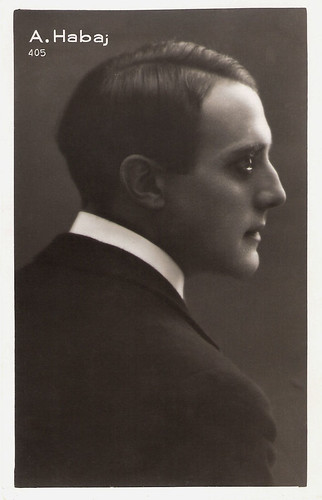
Italian postcard by Ed. Vettori, Bologna, no. 405. Photo: Pinto, Roma.

Italian postcard by Ed. Vettori, Bologna.
In the meantime André Habay had already started to act in two films by Ivo Illuminati with other actresses: La fanciulla di Capri/The Flower Girl of Capri (1914) with Leda Gys and La fiamma rossa/The Son of a Tyrant (1914) with Mary Cléo Tarlarini.
Then it was time to join Francesca Bertini again for her last film for Celio: Nella fornace/In The Furnace, a not-too-convincing film by Nino Oxilia, shot at the steel furnaces of Piombino.
Habay’s next role for Oxilia’s Rapsodia satanica/Satan's Rhapsody would have a longer-lasting echo, although the film had serious problems with its release. Already in 1914, Cines devised a major project around a female version of Goethe’s Faust, starring theatre and film star Lyda Borelli, and with a special score written by maestro Pietro Mascagni.
Oxilia shot the film in the winter of 1914-1915 and during a private show in early 1915, the audience was wildly enthusiastic about it. For unclear reasons, though, the film was refused public release, and only after heavy cuts, Rapsodia satanica was released in 1917 (not 1920 as IMDb claims). It was neglected by most of the press, while others considered it outdated already.
In the 1980s a restored black & white copy of the film was performed again with Mascagni’s music and made a big impression. In the meantime, a tinted and stencil-coloured version had been found and was restored as well. Parts of it were used for Peter Delpeut’s compilation film Diva dolorosa (1999). Habay plays Tristano, one of two brothers who are both in love with capricious, cruel Alba (Borelli). Tristano is even willing to betray his brother Sergio (Giovanni Cini), in order to get the love of Alba. When Sergio commits suicide, Tristano freaks out, but Alba tells him to leave. Her play is over.
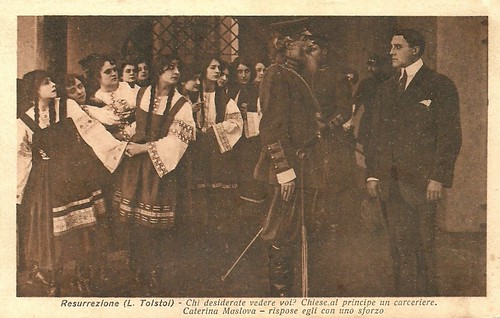
Italian postcard. Photo: Tiber-Film. Maria Jacobini and André Habay in Resurrezione (Mario Caserini, 1917), based on Leo Tolstoy's novel. Caption: Who do you wish to see? the guardian asked the prince. Katerina Maslova, he answered him with difficulty.
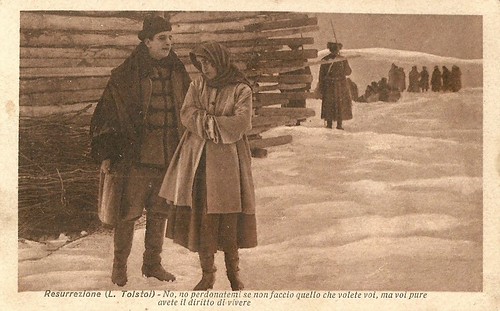
Italian postcard. Photo: Tiber-Film. Maria Jacobini and André Habay in Resurrezione (Mario Caserini, 1917), based on Leo Tolstoy's novel. Caption: Non, don't forgive me if I don't do what you want, but you have a right to live too.

Italian postcard by IPA CT Duplex, no. 5102. Photo: Tiber Film. André Habay in L'aigrette/The Egret (Baldassarre Negroni, 1917), based on the play by Dario Niccodemi. Caption: Intimity.
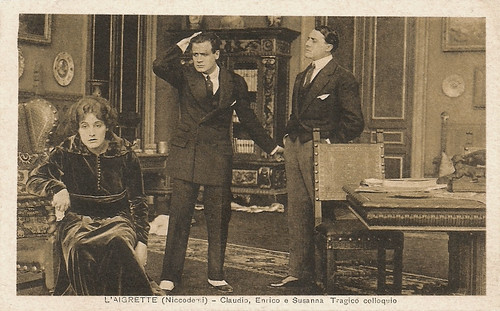
Italian postcard by IPA CT Duplex, no. 5108. Photo: Tiber Film. Caption: 'Claudio, Enrico, and Susanna. Tragic conversation'. Hesperia, Tullio Carminati, and André Habay in the Italian silent film L'aigrette (Baldassarre Negroni, 1917), misspelled by IMDb as L'aiglette and an adaptation of a stage play by Dario Niccodemi.
During the First World War, André Habay played in countless films, including Il capestro degli Asburgo/The Noose of the Habsburgs (Gustavo Serena, 1915) with Francesca Bertini and La falena/The Moth (Carmine Gallone, 1916) with Lyda Borelli, plus many films with actress Matilde di Marzio.
He played opposite Soava Gallone in Avatar/The Magician (Carmine Gallone, 1916), opposite Maria Jacobini in films like the Tolstoi adaptation Resurrezione/Resurrection (Mario Caserini, 1917), La sfinge/The Sphinx (Mario Caserini, 1918), L’articolo IV/Article IV (Gennaro Righelli, 1918), La regina del carbone/Queen Coal (Gennaro Righelli, 1919) and La vergine folle/The crazy virgin (Gennaro Righelli, 1920).
Habay co-starred with Hesperia in films like L’aigrette/The Egret (Baldassarre Negroni, 1917) and La principessa di Bagdad/The Princess of Baghdad (Baldassarre Negroni, 1918) and with Diana Karenne in films like La signora dalle rose/The lady With The Roses (1919), directed by Karenne herself, and Zoya (Giulio Antamoro, 1920).
In the early 1920s, Habay tried his luck with film directing and made Il mare/The Sea (1921), Il cielo/The Sky (1921), and Colui che seppe amare/One Who Knew How To Love (1921-1922). It was a short-lived career. Following the advice of the press who wrote he’d better continue to be the love interest of the divas, he did so in the early 1920s.
He co-starred with Italia Almirante Manzini in Il sogno d’amore/Dreams Of Love (Gennaro Righelli, 1922), L’ombra/The Shadow (Mario Almirante, 1923) and La grande passione/The Passion (Mario Almirante, 1923), with Soava Gallone in La fiammata/The Flare (Carmine Gallone, 1923) and La signorina .. madre di famiglia/Ms. .. Mother Of The Family (Carmine Gallone, 1924), with Hesperia in Il velo della colpa/The Veil Of Guilt (Baldassarre Negroni, 1923), and with Carmen Boni in Il riscatto/The Redemption (Guglielmo Zorzi, 1924).

Spanish postcard. Hesperia and André Habay in La principessa di Bagdad/The Princess Of Bagdad (Baldassarre Negroni, 1918).

Spanish collectors card in the Colec. cromos cinematográficos by Chocolat Imperiale, no. 6 (in a serie of 6 cromos). Photo: Tiber-Film, Roma / J. Verdaguer, Barcelona. Hesperia and André Habay in La principessa di Bagdad/The Princess Of Bagdad (Baldassarre Negroni, 1918).

Spanish cromo. Photo: Tiber Film. Maria Jacobini, André Habay, and Alberto Collo in La sfinge/The Sphinx (Mario Caserini, 1918).

Italian postcard by Ed. Vettori, Bologna, no. 1040. Photo: Tiber Film. Maria Jacobini and André Habay in La vergine folle (Gennaro Righelli, 1920).
André Habay’s last parts were no longer in the diva films – the genre had become outdated by now. He appeared in an epic film and in two Strong Men films. First, he played the lucid Petronius, ‘arbiter elegantiarum’ of Emperor Nero, in Quo Vadis? (Gabriellino D’Annunzio, Georg Jacoby, 1924-1925), and adapted from the famous novel by Henryk Sienkiewicz.
The lavish production by the UCI (Unione Cinematografica Italiana) had a mixed German-Italian cast with Emil Jannings playing Nero, surrounded by 'baddies' such as Elena Sangro as his wife Poppea, Raimondo van Riel as the ruthless general Tigellinus, and Gino Viotti as the perfidious Chilo Chilonides. On the good side were Alphons Fryland as Vinicius, Lilian Hall-Davis as Lygia, Rina de Liguoro as Eunice, and Elga Brink as Domitilla. Strong man Bruto Castellani, who had played the protector of Lygia in the 1913 Cines version, played the same role again in this version.
The production was haunted by trouble: various parties claimed rights and UCI had to pay them all. Moreover, during the shooting, an extra was assaulted and killed by a lion. Despite the cast, the enormous sets and the numerous extras, the film was not the big success the Italians had hoped for. Though the press praised Jannings’ performance, they thought that they knew the reconstruction of ancient Rome by now. (Were they in for a shocker, as one year after, MGM’s Ben-Hur: A Tale of the Christ (Fred Niblo, 1925) starring Ramon Novarro appeared…)
André Habay's last parts were minor roles in two late Maciste-films: Maciste nella gabbia dei leoni/Maciste in the Lions' Den (Guido Brignone, 1926) and Il gigante delle Dolomiti/The giant of the Dolomites (Guido Brignone, 1926). In the latter film, Habay played for the last time the romantic love interest (this time Dolly Grey). At the same time, the plot contains a spy story, and Habay plays an engineer whose plans for a new aeroplane are almost stolen.
In a way, this makes this full circle with Habay’s earliest films with Francesca Bertini, as well as combinations of spy stories and romantic dramas. This time, however, it is not Bertini’s pluck but Maciste’s strong arms that set things straight. In 1941, André Habay died in Rome, Italy at the age of 57.

Italian postcard, no. 25. Photo: Società cinematografica FERT. Italia Almirante Manzini and André Habay in La grande passione/The Passsion (Mario Almirante, 1922). Caption: Joint life in their retreat.

Italian postcard, no. 28. Photo: Società cinematografica FERT. Italia Almirante Manzini and André Habay in La grande passione/The Passion (Mario Almirante, 1922). Caption: You want to flee with me... forever?
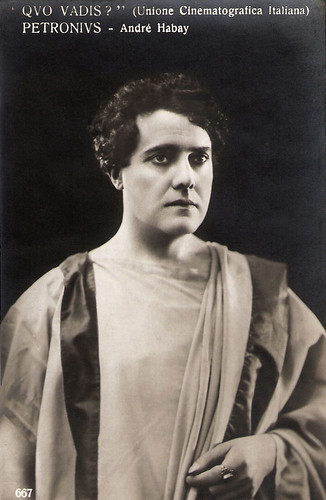
Italian postcard by Ed. A. Traldi, Milano, no. 667. Photo: André Habay as Petronius in Quo Vadis? (1924-1925).
Sources: Aldo Bernardini/Vittorio Martinelli (Il cinema muto italiano), and IMDb.
This post was last updated on 23 July 2024.

German postcard, no. 698/6. Photo: Filmhaus Bruckmann. André Habay as Petronius in Quo Vadis? (1924-1925).

Probably a British postcard. Photo: K-Ltd.

Italian postcard, no. 172.
Divas
André Habay (aka Andrea Habay, A. Habaj or A. Kabaj) was born in Paris, France in 1883. Nothing more is known about his French whereabouts.
What we do know is that he had a rich career in Italian silent cinema, which started just before the First World War and continued until the mid-1920s. His first part was probably in the Spanish-Italian film Carmen, directed by Giovanni Doria and Augusto Turqui, and released in Spain in 1914, according to IMDb. Strangely enough, the film lacks in the otherwise excellent reference books of 'Il cinema muto italiano' by Bernardini & Martinelli. French actress Suzy Prim played Carmen, while Habay was Don José. For both, it meant the start of a career in Italian silent film, though Habay's Italian career was more intense and longer-lasting than Prim's.
From 1914 on, Habay worked regularly for Cines or rather its affiliated company Celio. He began as the leading man of diva Francesca Bertini. Their first film together was the tragic melodrama Onestà che uccide/Honesty That Kills (Maurizio Rava, 1914). It was well-received.
Their next film, the spy story La principessa misteriosa/The Mysterious Princess (Maurizio Rava, 1914), repeated the plot of Bertini’s previous L'amazzone mascherata/The Masked Rider (Baldassarre Negroni, 1913) and did not stir much.
Their subsequent film, Sangue blu/Sangue bleu (Nino Oxilia, 1914) was explicitly built up to lift Bertini to the status of a diva, and it succeeded. In all these films Angelo Gallina acted as the older man, as opposed to the younger one, played by Habay. In Sangue Blu Bertini is a countess who divorces her unfaithful husband (Gallina). Acting in a philanthropist stage play, she meets actor Jack Wilson (Habay). A compromising picture of the two makes the countess lose her child. Wilson proves to be a ruthless exploiter who robs her and forces her to act on stage. During a tango of death, she desperately stabs herself but doesn’t die. Her husband repents and the family is reunited. The film was an international success and paved the way for Habay as well.

Italian postcard by Ed. A. Traldi, Milano, no. 6?. Photo: Pinto, Rome. Habay's first name is misspelt on this card.

Italian postcard by Ed. Vettori, Bologna, no. 352. Photo: Pinto, Roma. André Habay is misspelt here as 'Kabaj'.

Italian postcard by Ed. Vettori, Bologna, no. 405. Photo: Pinto, Roma.

Italian postcard by Ed. Vettori, Bologna.
Satan's Rhapsody
In the meantime André Habay had already started to act in two films by Ivo Illuminati with other actresses: La fanciulla di Capri/The Flower Girl of Capri (1914) with Leda Gys and La fiamma rossa/The Son of a Tyrant (1914) with Mary Cléo Tarlarini.
Then it was time to join Francesca Bertini again for her last film for Celio: Nella fornace/In The Furnace, a not-too-convincing film by Nino Oxilia, shot at the steel furnaces of Piombino.
Habay’s next role for Oxilia’s Rapsodia satanica/Satan's Rhapsody would have a longer-lasting echo, although the film had serious problems with its release. Already in 1914, Cines devised a major project around a female version of Goethe’s Faust, starring theatre and film star Lyda Borelli, and with a special score written by maestro Pietro Mascagni.
Oxilia shot the film in the winter of 1914-1915 and during a private show in early 1915, the audience was wildly enthusiastic about it. For unclear reasons, though, the film was refused public release, and only after heavy cuts, Rapsodia satanica was released in 1917 (not 1920 as IMDb claims). It was neglected by most of the press, while others considered it outdated already.
In the 1980s a restored black & white copy of the film was performed again with Mascagni’s music and made a big impression. In the meantime, a tinted and stencil-coloured version had been found and was restored as well. Parts of it were used for Peter Delpeut’s compilation film Diva dolorosa (1999). Habay plays Tristano, one of two brothers who are both in love with capricious, cruel Alba (Borelli). Tristano is even willing to betray his brother Sergio (Giovanni Cini), in order to get the love of Alba. When Sergio commits suicide, Tristano freaks out, but Alba tells him to leave. Her play is over.

Italian postcard. Photo: Tiber-Film. Maria Jacobini and André Habay in Resurrezione (Mario Caserini, 1917), based on Leo Tolstoy's novel. Caption: Who do you wish to see? the guardian asked the prince. Katerina Maslova, he answered him with difficulty.

Italian postcard. Photo: Tiber-Film. Maria Jacobini and André Habay in Resurrezione (Mario Caserini, 1917), based on Leo Tolstoy's novel. Caption: Non, don't forgive me if I don't do what you want, but you have a right to live too.

Italian postcard by IPA CT Duplex, no. 5102. Photo: Tiber Film. André Habay in L'aigrette/The Egret (Baldassarre Negroni, 1917), based on the play by Dario Niccodemi. Caption: Intimity.

Italian postcard by IPA CT Duplex, no. 5108. Photo: Tiber Film. Caption: 'Claudio, Enrico, and Susanna. Tragic conversation'. Hesperia, Tullio Carminati, and André Habay in the Italian silent film L'aigrette (Baldassarre Negroni, 1917), misspelled by IMDb as L'aiglette and an adaptation of a stage play by Dario Niccodemi.
Love interest
During the First World War, André Habay played in countless films, including Il capestro degli Asburgo/The Noose of the Habsburgs (Gustavo Serena, 1915) with Francesca Bertini and La falena/The Moth (Carmine Gallone, 1916) with Lyda Borelli, plus many films with actress Matilde di Marzio.
He played opposite Soava Gallone in Avatar/The Magician (Carmine Gallone, 1916), opposite Maria Jacobini in films like the Tolstoi adaptation Resurrezione/Resurrection (Mario Caserini, 1917), La sfinge/The Sphinx (Mario Caserini, 1918), L’articolo IV/Article IV (Gennaro Righelli, 1918), La regina del carbone/Queen Coal (Gennaro Righelli, 1919) and La vergine folle/The crazy virgin (Gennaro Righelli, 1920).
Habay co-starred with Hesperia in films like L’aigrette/The Egret (Baldassarre Negroni, 1917) and La principessa di Bagdad/The Princess of Baghdad (Baldassarre Negroni, 1918) and with Diana Karenne in films like La signora dalle rose/The lady With The Roses (1919), directed by Karenne herself, and Zoya (Giulio Antamoro, 1920).
In the early 1920s, Habay tried his luck with film directing and made Il mare/The Sea (1921), Il cielo/The Sky (1921), and Colui che seppe amare/One Who Knew How To Love (1921-1922). It was a short-lived career. Following the advice of the press who wrote he’d better continue to be the love interest of the divas, he did so in the early 1920s.
He co-starred with Italia Almirante Manzini in Il sogno d’amore/Dreams Of Love (Gennaro Righelli, 1922), L’ombra/The Shadow (Mario Almirante, 1923) and La grande passione/The Passion (Mario Almirante, 1923), with Soava Gallone in La fiammata/The Flare (Carmine Gallone, 1923) and La signorina .. madre di famiglia/Ms. .. Mother Of The Family (Carmine Gallone, 1924), with Hesperia in Il velo della colpa/The Veil Of Guilt (Baldassarre Negroni, 1923), and with Carmen Boni in Il riscatto/The Redemption (Guglielmo Zorzi, 1924).

Spanish postcard. Hesperia and André Habay in La principessa di Bagdad/The Princess Of Bagdad (Baldassarre Negroni, 1918).

Spanish collectors card in the Colec. cromos cinematográficos by Chocolat Imperiale, no. 6 (in a serie of 6 cromos). Photo: Tiber-Film, Roma / J. Verdaguer, Barcelona. Hesperia and André Habay in La principessa di Bagdad/The Princess Of Bagdad (Baldassarre Negroni, 1918).

Spanish cromo. Photo: Tiber Film. Maria Jacobini, André Habay, and Alberto Collo in La sfinge/The Sphinx (Mario Caserini, 1918).

Italian postcard by Ed. Vettori, Bologna, no. 1040. Photo: Tiber Film. Maria Jacobini and André Habay in La vergine folle (Gennaro Righelli, 1920).
Haunted by trouble
André Habay’s last parts were no longer in the diva films – the genre had become outdated by now. He appeared in an epic film and in two Strong Men films. First, he played the lucid Petronius, ‘arbiter elegantiarum’ of Emperor Nero, in Quo Vadis? (Gabriellino D’Annunzio, Georg Jacoby, 1924-1925), and adapted from the famous novel by Henryk Sienkiewicz.
The lavish production by the UCI (Unione Cinematografica Italiana) had a mixed German-Italian cast with Emil Jannings playing Nero, surrounded by 'baddies' such as Elena Sangro as his wife Poppea, Raimondo van Riel as the ruthless general Tigellinus, and Gino Viotti as the perfidious Chilo Chilonides. On the good side were Alphons Fryland as Vinicius, Lilian Hall-Davis as Lygia, Rina de Liguoro as Eunice, and Elga Brink as Domitilla. Strong man Bruto Castellani, who had played the protector of Lygia in the 1913 Cines version, played the same role again in this version.
The production was haunted by trouble: various parties claimed rights and UCI had to pay them all. Moreover, during the shooting, an extra was assaulted and killed by a lion. Despite the cast, the enormous sets and the numerous extras, the film was not the big success the Italians had hoped for. Though the press praised Jannings’ performance, they thought that they knew the reconstruction of ancient Rome by now. (Were they in for a shocker, as one year after, MGM’s Ben-Hur: A Tale of the Christ (Fred Niblo, 1925) starring Ramon Novarro appeared…)
André Habay's last parts were minor roles in two late Maciste-films: Maciste nella gabbia dei leoni/Maciste in the Lions' Den (Guido Brignone, 1926) and Il gigante delle Dolomiti/The giant of the Dolomites (Guido Brignone, 1926). In the latter film, Habay played for the last time the romantic love interest (this time Dolly Grey). At the same time, the plot contains a spy story, and Habay plays an engineer whose plans for a new aeroplane are almost stolen.
In a way, this makes this full circle with Habay’s earliest films with Francesca Bertini, as well as combinations of spy stories and romantic dramas. This time, however, it is not Bertini’s pluck but Maciste’s strong arms that set things straight. In 1941, André Habay died in Rome, Italy at the age of 57.

Italian postcard, no. 25. Photo: Società cinematografica FERT. Italia Almirante Manzini and André Habay in La grande passione/The Passsion (Mario Almirante, 1922). Caption: Joint life in their retreat.

Italian postcard, no. 28. Photo: Società cinematografica FERT. Italia Almirante Manzini and André Habay in La grande passione/The Passion (Mario Almirante, 1922). Caption: You want to flee with me... forever?

Italian postcard by Ed. A. Traldi, Milano, no. 667. Photo: André Habay as Petronius in Quo Vadis? (1924-1925).
Sources: Aldo Bernardini/Vittorio Martinelli (Il cinema muto italiano), and IMDb.
This post was last updated on 23 July 2024.
No comments:
Post a Comment